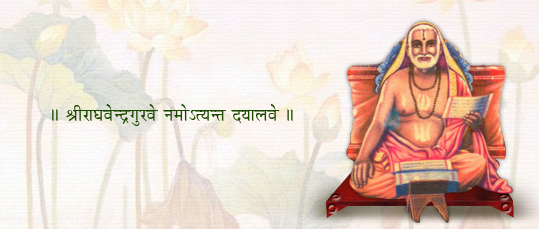ARADHANA 2007
Sri Raghavendra Swamy Mutt - Mantralaya
Emphasis of gradation by Rayaru

Author: Vidwan Sri Keshava Tadipatri, USA
-------------------------------------------------------------------------------------------------------------------------------------
Shri Raghavendra Swamiji's "Mantrartha Manjari" is pioneering contribution to Vedic literature. Mantrartha Manjari's "Preface" is torch light for for the students of Vedic literature. For the whole Vedic literature, it is a valuable introduction(bhoomike). It opens a door to astonishing world of vedas.
It was Acharya Madhwa who for the first time in history
introduced Vedarth Chintana by writing bhashya to 40 suktaas to
Ruk Samhite.
For the first time Acharya Madhwa declared:
1. All the Vedas essentially declare one God;
2. all words and sounds essentially are names of the God.
3. There is no word which doesn't refer to God's name.
Many of Panditas who were karmatas of old style (rigid) got a massive shock with the above thoughts. Many people are unable to digest this even as of today. Even after this declaration by Acharya people like SaayaNa still continued in the same line.
Acharya delcared "trayorthaah sarvavEdEShu", every
mantra of Veda has 3 meanings
The meemasaka who firmly belived "
one word/sentence conveys one meaning" found it impossible to
digest these words. In reality every word has many
meanings:
For ex: the word 'aatma' means
1. externally visible body
2. mind
3. self (jeeva)
4. paramaatma
This is natural way for the bhasha shaastra to interpret the
meanings, but this didn't occur to meemasakas and surprisingly
to "bhaasha shaastra" panditas. These panditas/meemasakas didn't
adapt to Achrya's opinion,they continued cramming(getting by
heart) the old way. This inner meaning of bhaasha shaastra was
first made public by Achrya Madhwa.
Many panditas didn't understand Acharya's shastra/bhaaShya. To
understand this these panditas started reading "tarkaShaastra",
this yielded more confusion than making them understand
Acharya's shastra/bhaaShya. The study of tarka shaastra instead
of turning in to "sutarka" turned to "kutarka". Sadly these 'avidyavanta'
panditas became famous ,bold and got recognition of the people.
So tarka(logic) grew, while the reality suffered and suffocated.
Here the role of Sri RaaghavEndra swamiji becomes very
important. He made "tarka" to "sutarka". He used meemasakas
tarka itself to convince them about vedas having 3 meanings. He
also supplemented tarka with "shaastra puraNa" to convince these
meemasakas.With these explanations he challenged our thinking
and made every one to think.
He said 3 meanings mean
1. 1 prominent meaning (mukhya artha)
2. 2 very prominent meaning (param mukhya artha)
He illustrated this with word "agnImILe" which means "I pray
agni". Sri RaaghavEndra swamiji didn't pray fire, instead he
prayed agni dEva inside the fire. He prayed "agni naaraayaNa"
who dwells inside "agni dEva".
So the literal meaning of agni "fire" became less important. So
1. agni dEva is mukhya artha
2. "agni devaa's" antaryaami "agni naaraayaNa" is param mukhya
artha, "shloka?", further to this,
3. agni just doesn't mean "agni antaryaami" it also mean "antaryaami
of jeeva(mama)"(this is another param mukhya artha, essentially
adhyatmik artha)
'aga'means immobile jeeva the mirror image of god. It is
paramatma as antaryami is responsible for putting mobility in to
this jeeva. So the paramatma is addressed as 'agni'.
During the yajna if one uses the term 'agni' it means "agni
naaraayaNa" who dwells inside "agni dEva". During the meditation
if a jeeva(worshipper/devotee) uses the term 'agni' it means "narayaNa
the antaryami of that particular jeeva"
This way every deva mantra has "2 very prominenet meanings"
1. mantra's prominent devantargat narayaNa(in the above scenario
agnyantargat narayaNa)
2. worshipper's bimba roopa(?) narayaNa.
By explaining this very well Sri RaaghavEndra swamiji has done a
great service to all devotees.
What needs to be mentioned here is about Mantrartha Manjari's
'Preface'. This is an excellent contribution.
Acharya Madhwa in his support of tatvavaada quoted many
references in his works. Some references out of this list are
not available now.
This made people opposing 'tatvavaada' to say the list of
references quoted by Acharya was 'self creation'. None of the
ancient authors countered their argument except RaaghavEndra
swami. He countered this with the following argument:
Elders(in this case Acharya) have seen lot scriptures, because
of that they refer to them. RaaghavEndra swami said "it is
improper of the foolish panditas having read few scriptures only
to complain against Acharya. He said these panditas should be
ashamed of themselves". This way he cautioned the people
opposing 'tatvavaada' and Acharya.
He didn't stop there:
He said "there are many authors who referenced the non-existing
scriptures and how can these people(accusing Acharya) accept
this?". If this can be accepted then why not Acharya's
literarture.
For every argument of ours there is attached our own
religion/caste unknowingly. RaaghavEndra swami shows to us that
why their argument is false, this he illustrtaes further:
"shaambara bhaashya" also quotes references which are not
available now. What is take of meemasakas on this one?
Also "shaankara bhaashya"quotes references from some "vEda
vaakya" which are no longer available? What is take of shamkaras
followers on this one?
RaaghavEndra swami's these defending statements not only defend
himself but also Acharya Madhwa. This way he analysed the
problem in a wonderful way.
Luckily some parts of vEdas whom meemasakas called "self
creation" are available now. This further extends support to
RaaghavEndra swami's argument.
Like this many new thoughts guruRaaghavEndra's "Mantrartha
Manjari" brings out, especially "Preface" which is very
impoartant for Vedic literature. So Shree Raghavendra swami's
this masterpiece to Vedic literature is invaluable.